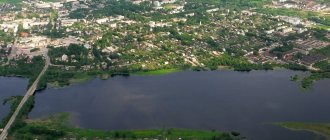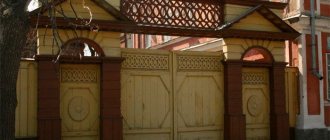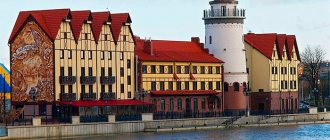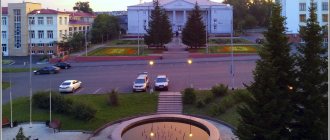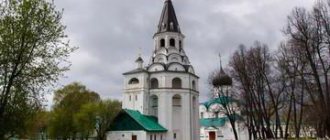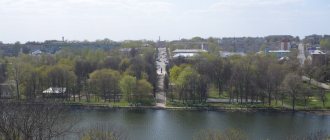| Azov. Photo from the website of the Azov city administration. |
Azov
, a city in Russia, constitutes the Azov Urban Okrug and is the administrative center of the Azov District of the Rostov Oblast, within the Diocese of Rostov-on-Don. Located on the left bank of the Don, 7 km from its confluence with the Taganrog Bay of the Sea of Azov, 41 km southeast of Taganrog, 42 km southwest of Rostov-on-Don. Sea and river port, railway station. Population - 82.9 (2011).
- On the map: Yandex.Map, Google map
In the 3rd century, on the territory of the future city, there were two agricultural settlements of the Maeotians, mentioned by Ptolemy under the names Paniardis
and
Patarva
and part of the system of fortified settlements located around the city of Tanais, which belonged to the Bosporan kingdom. At the beginning of the 3rd century, these settlements perished under the onslaught of aliens.
There is an opinion that in centuries on the site of the current city there was a Slavic settlement as part of the Tmutarakan principality, which was captured by the Polovtsians around 1067. There is also a historical and literary tradition that dates the founding of the city to 1067 and connects the name of the city with the name of the Polovtsian khan Azup.
One way or another, in the 13th century the Golden Horde city of Azak
(the main version of the origin derives the name from the Turkic
azak
- “river mouth”).
In the part of Azak adjacent to the Don, a colony of Genoese and Venetians formed, who named it Tana
in honor of the ancient Tanais, located nearby. Azak-Tana soon became one of the centers of world trade - the “great trade route” between Europe and China passed through it, as well as the key artery of communication between the north of Eurasia and Constantinople. The city became a major slave trading market and a large craft center, with its own mint operating here in the 14th centuries. Archaeological evidence shows that in the 14th century the city was one of the largest in the world; The Arab traveler Ibn Batuta, after visiting Azak in 1333, noted that the city was distinguished by its beautiful construction. The consul of the Venetian trading post in Azov in the middle of the 14th century was the highest-ranking official representative of the Doge in the Northern Black Sea region [1]. In 1395 it was defeated by the troops of Tamerlane.
In 1471 [2] the city was captured by the Turks and turned into a powerful military fortress of the Ottoman Empire. During this era, the original name Azak was turned into Azau
, which passed into Russian as
Azov
. The fortress became a key strategic point - it turned the Azov and Black Seas into the internal seas of the Ottoman Empire, allowed control of the vassal Crimean Khanate, served as a base for connections with Kazan and Astrakhan, as well as a springboard for raids on Russia. At the end of the 16th century, the city also remained an important center of international trade, with Ottoman, Russian and Persian merchants constantly arriving here. Special goods were fish (the Turks even called Azov “the Sultan’s fish yard”), black caviar and Russian slaves.
Russian-Turkish struggle for Azov
With the strengthening of Russia and the Cossacks in the 17th century, a chain of Russian-Turkish wars began, in which Azov invariably played a key role. In June 1637, detachments of Zaporozhye and Don Cossacks, after a two-month siege, captured Azov by storm. The city became the capital of the Don Army. In the summer of 1641, the Ottoman Empire sent a strong fleet and ground forces here to capture Azov. However, the siege that lasted from June to September—the “Azov Sitting”—ended in vain. Only in the summer of 1642 did the Cossacks leave Azov by royal decree, destroying the fortifications.
After this, the city was re-fortified by the Turks and continued to play the role of a key Ottoman outpost, blocking Russia’s access to the southern seas. In 1695, during the first Azov campaign of Tsar Peter I, Russian troops besieged Azov from land, but after two unsuccessful assaults they were forced to retreat. In the summer of 1696, this time with the assistance of the ships of the Azov flotilla, specially built in winter in Voronezh, Russian troops captured Azov. On July 19, the Turks left the city and Russia gained access to the southern seas.
Tsar Peter I intended to firmly establish himself in the Azov region, which led to a number of initiatives to develop the city. Masses of people were drawn to the city - exile to Azov was then even replaced by the death penalty. Construction work began immediately - the fortress was restored, a harbor was built, construction of the Admiralty and the Azov fleet began. Since 1708, the city became the center of the vast Azov province. In the same year, the rebellious Cossacks of Bulavin approached the Azov fortress, but the garrison held out, the rebel was quartered in Azov, and the lands of the guilty Donskoy army became part of the Azov province. However, after the unsuccessful Prut campaign of Russian troops, according to the agreement of April 5, 1712, Russia was forced to return the city to the Ottoman Empire.
In June 1736, during the Russian-Turkish War, Russian troops again captured the city, but according to the Belgrade Peace Treaty of 1739, the city was included in the “barrier” lands - although they remained with Russia, their fortifications were destroyed and the garrisons were withdrawn.
Only in 1769, during the next Russian-Turkish War, the fortress began to be rebuilt along the “old lines”. In 1774, according to the Treaty of Kyuchuk-Kainardzhi, the city was assigned to Russia.
Russian Azov
In 1775-1782 - the center of the Azov province, from 1783 - a provincial town of the Ekaterinoslav governorate, in 1796-1802 - in the Novorossiysk province, from 1802 - a posad of the Rostov district of the Ekaterinoslav province.
Since the end of the 18th century, Azov was a border flank fortress on the Azov-Mozdok line, abolished in 1810. After the annexation of Crimea and Kuban to Russia, the need to maintain a military fortress disappeared and in 1810 it was abolished.
Since 1888 - as part of the Don Army Region. The revival of Azov in the 19th century was largely associated with the development of grain trade and the activities of the international Azov trading port.
On January 27, 1918, the Bolsheviks proclaimed Soviet power here; from the summer of 1918 to the beginning of 1920, Azov was in the hands of white forces and a concentration camp for captured Red Army soldiers was organized here. On March 1, 1920, Azov was occupied by the Reds. Azov became the administrative center of the Azov region, and in 1926 it again received the status of a city.
During the 1920s and 1930s, a number of industrial enterprises were established in the city. During the Great Patriotic War, it was occupied by Nazi troops on July 27, 1942 and liberated on February 7, 1943. Every second house was destroyed, industry was in decline. At the end of the 1940s, along with the restoration of old enterprises, the construction of large factories began.
In 1957 it became a city of regional subordination; industry and capital construction developed rapidly. By the end of the Soviet period, factories of forging and pressing equipment, forging and pressing machines, and commercial equipment were operating; there were shipbuilding, light industry, food industry, production of building materials; There were polytechnic and industrial-pedagogical technical schools, and a pedagogical school. As Rostov-on-Don grew, Azov entered its agglomeration.
Statistics
- 1824 - 888 people, 2 churches [3]
- 1856 - 5.3 thousand people, 1 church, 980 houses, 24 shops
- 1897 - 27.5 thousand people
- 1931 - 19.8 thousand people
- 1959 - 39.9 thousand people
- 1973 - 66 thousand people
- 1989 - 80.3 thousand people
- 2003 - 82.1 thousand people
Azov - how to get there
The city's railway station is located 30 km from the Bataysk railway junction station, and can also be reached from the regional center, the city of Rostov-on-Don:
- By electric train or bus, travel time is 1 hour
- By boat - 30 minutes
- By minibus, travel time will be about 40 minutes.
Azov is an international seaport located less than 10 km from the Taganrog Bay of the Sea of Azov. Sea vessels and river-sea motor ships with a draft of up to four meters arrive here.
Recreation and entertainment
Azov, whose attractions attract Russian and foreign travelers, provides city guests with many opportunities for recreation and entertainment. The city has billiard clubs, karaoke clubs, entertainment centers, bars, cafes and restaurants. You can dance and watch shows in the Tortuga tavern, located on the banks of the Don.
The Krepostnoy Val restaurant is famous for its cozy atmosphere, relaxed atmosphere and good service.
The theatrical life of the city is represented by the folk children's theater "Gorodok" and the theater "KUL-SHOW", offering viewers interesting performances, shows, television projects and films.
Of interest to anglers is fishing on the Don, which is popular among connoisseurs and is rich in fish that live there. Lucky fishermen can catch pike perch weighing up to 7 kg. Catfish is considered a good catch. On the territory of the city there are green areas: a park of culture and recreation and the Pearl of Azov Park. The river station invites tourists on river walks and excursions on motor ships.
Every year in the first days of August, a festival of military history clubs takes place in Azov, which lasts several days. The main event of the festival is a theatrical reconstruction of the Cossacks sitting during the siege on the historical site of their feat - the ramparts.
Don't miss the most popular article in the section: Metro Nizhny Novgorod. Diagram, map, description.
Foundation of the city
There are several versions regarding the founding date of the city and debates about its age are still ongoing:
- According to many scientists, the history of Azov began more than two thousand years ago, when the first Scythian settlements arose on this territory
- The official founding date of the city is 1067, as evidenced by entries in the Geographical Dictionary of the Russian State dated 1801
- At the same time, there is no archaeological data on the population living in this area during the period of the 11th–12th centuries, and the first written mention of the Golden Horde city of Azak-Tana dates back only to 1269. Later, in 1471, Azov was taken by the Turks, who built the Azak fortress here.
Walls of the Venetian trading post Tana
On the street Yaroslavsky, 10, during the laying of a water pipeline in 2012, a fragment of the wall of the Venetian-Genoese trading post of Tana, located on the site of modern Azov in the 15th century, was discovered.
It was not for nothing that the Italians built their trading port here. This place was an excellent point on the route to Persia, known as the Great Silk Road. The ancient, well-known craft and trading settlement was mercilessly destroyed by the troops of Tamerlane.
History of Azov
Don seat
In 1637, the Don Cossacks, together with the Cossacks, led by Mikhail Ivanovich Tatarinov, blocked the fortress and carried out a series of raids across the Black Sea from it. The Turks tried to retake the city, but to no avail. Thus, the Turkish military leader Huseyn-Deli wrote to the Sultan: “We have monstrous losses. We conquered entire kingdoms, and now we bear the shame of an insignificant handful of Zaporozhye Cossacks. They are not people. They are shaitans who have taken human form. According to the Janissaries, they stop bullets, catch cannonballs with the skirts of their caftans, dissolve in the air and suddenly strike from behind.”
In 1642, the Don Cossacks themselves abandoned the fortress, unable to hold it. The years from 1637 to 1642 went down in history as the “Don Seat”. And although Azov did not become part of Russia as a result of these events, it was important that since then the Don people have never acted together with the hostile forces of Russia.
Capture of Azov
The first Azov campaign of Peter the Great in 1695 ended in failure. The 31,000-strong Russian army held a siege from July 9 until the end of September, but was never able to take the city.
The second campaign took place in 1697. During its preparation, new ships were built in Voronezh, including sea galleys and river plows, as well as two large 36-gun galleasses. The number of ground forces reached 75 thousand people, that is, it more than doubled, and the personnel of the fleet under the command of Franz Lefort amounted to 4225 soldiers. The overall command was carried out personally by Peter the Great.
The Russian fleet broke through to the coast and blocked the fortress from the sea. At the same time, a siege began from the land side. After shelling the fortress, the Turks bowed their banners and sent out their envoys. They agreed to leave the fortress on the condition that their wives and children be released with them and that all their property be seized.
On the morning of July 19, the Turks left the fortress and the city commander handed over the keys to the fortress to the Russian command.
In 1711, the Prut campaign in Moldova against the Ottoman Empire ended in defeat, as a result, according to the agreement, the Azov fortress was destroyed and abandoned by Russian troops, and its inhabitants were resettled in the Voronezh province.
In 1736, during the Russian-Turkish war, the Azov fortress was taken. According to the Belgorod Peace Treaty, concluded in 1739, the city ceded to Russia subject to the destruction of the fortifications.
In 1926, Azov was given city status. During the Great Patriotic War, from June 27, 1942 to February 7, 1943, the city was occupied by the Nazi invaders.
Education
The structure of the education system in the Azov region is the largest in the region. It unites 70 educational schools, 2 children's creativity centers, 40 kindergartens and other educational institutions. The material base of educational institutions in the region is being strengthened. Recently, 6 schools and 3 kindergartens have been overhauled. Preschool educational institutions have been reopened in the villages: Novomargaritovo, Otradovka, Orlovka, Novoaleksandrovka, Ovoshchnoy. Modern computer classes have been opened in 29 secondary and 14 basic schools. Every month, the most gifted children are paid a personal scholarship from the head of the Azov region. The region has accumulated a wealth of experience in military-patriotic education of youth. Every year, the military sports game “Zarnitsa” is held in the Alexander Forest.
Sights of Azov
- Remains of the Azov fortress. Parts of the walls and a moat, the Alekseevsky Gate and two earthen ramparts have been preserved from it, on one of which models of cannons are installed
- Azov Museum of Local Lore, which houses a collection dedicated to the history of the city and its surroundings, as well as a separate exhibition of Scythian and Sarmatian gold, unique ceramics and copper products, paleontological finds, including the world’s only skeleton of a trogontherian elephant
- The powder magazine is an architectural monument of military engineering art of the late 18th century. This is the only example of fortress construction from the time of Catherine II preserved in the south of Russia. The powder magazine is a branch of the Museum of Local Lore, here you will see the diorama “The Capture of the Turkish Fortress of Azov by the Troops of Peter I in 1696”
- Monument to Peter the Great's comrade-in-arms Alexei Semenovich Shein, the first Russian generalissimo, governor of the second Azov campaign
- The monument boat was erected in 1975 in memory of the battles of the Azov military flotilla in 1941–1942
- Mill of the Cossack Nikita Nikitich Bulanov.
What to bring as souvenirs
Travelers bring as souvenirs from Azov:
- products with marine and military themes;
- figurines, dishes, clothes with maritime symbols;
- goods associated with Cossack paraphernalia: weapons, hats, cups;
- Azov wine;
- smoked fish;
- shell products.
Tourists who have visited Azov enthusiastically talk about the sights, shady parks and cozy cafes of the city, the panorama of which opens up when visiting the observation deck.
Author: Alekseeva Irina
Article design: Oleg Lozinsky
Temples
The Church of the Azov Icon of the Mother of God was built in 2000. The one and a half meter bell “Prince Vladimir” weighing 1270 kg, cast using ancient technologies in the city of Kamensk-Uralsky
- The Church of St. Nicholas was built in 2009
- The Church of the Life-Giving Trinity was built in the 1990s.
The city of Azov is older than Rostov-on-Don, Moscow and St. Petersburg, Voltaire, Alexei Tolstoy and Valentin Pikul wrote about it, and the famous researcher Thor Heyerdahl conducted excavations here. The city is unique due to its combination of a rich historical past, powerful industrial potential and great prospects.
Agriculture
Crop production
In terms of its production profile, the Azov region is agricultural and in recent years has been steadily developing as a single agro-industrial complex. A scientifically based farming system is being introduced on farms, correct agricultural cultivation techniques are used, and variety renewal is carried out in a timely manner using high-yielding varieties of agricultural crops. Gross grain production has increased, and the yield of all agricultural crops has increased significantly. For grains, the growth over five years was 12.6 c/ha, for sunflower – 6.2 c/ha, for vegetables – 61.8 c/ha. The district leadership is pursuing a policy of reorganizing all unprofitable and low-profitable enterprises; there are practically no unprofitable farms left in the district. In general, the profitability of the agricultural industry is 35-40%. The best results in crop production were achieved by the following farms: named after Dzerzhinsky, “Rybak Priazovya”, “Zarya”, “Pobeda”, “Primorsky”, where the grain yield “per round” exceeded 44 c/ha. In the fishing industry, the diversified enterprise “Socialist Way” sets the tone.
Livestock
In terms of a set of quality indicators in livestock farming, the Azov region is a leader among other regions of the region. This result became possible thanks to the introduction of advanced technologies in farms and the adoption of non-standard solutions by the district leadership in this industry. For example, the task of increasing the number of livestock at the expense of farms that have not previously been involved in livestock farming is being successfully solved. The breed achieved the highest milk yield per cow in the region – approx. 5 thousand liters per year. The feed mill and other agricultural enterprises of the Azov region have close ties of cooperation with a number of Dutch and German companies in terms of cultivation, joint production and processing of agricultural products.
Sports, tourism
Physical education and sports are actively developing in the Azov region. The total number of people regularly involved in physical education and sports exceeds 10 thousand people. Football, volleyball, chess, athletics, sailing, equestrian and weightlifting, Greco-Roman wrestling, cycling, and billiards are very popular among residents. Field hockey is actively cultivated. In recent years, athletes from the Azov region have achieved great success at international, all-Russian, regional competitions, and were winners of the regional rural sports competition. The material sports base is being updated in the region: the construction of a specialized sports complex for team sports has begun in the village of Kuleshovka, it is planned to build a large sports complex in the village of Port Katon, and the construction of a modern rural stadium in the village of Otradovka. The head of the district, V.N. Bevzyuk, is actively involved in sports and is the president of the district teenage club “Centaur”.
The nature and climate of the Azov region contribute to the development of tourism. In the summer months in the Azov region you can meet vacationers from all regions of Russia. Magnificent tourist complexes are at your service: “Cossack Watch”, “Breeze”, “Alexandrovsky Forest”.

